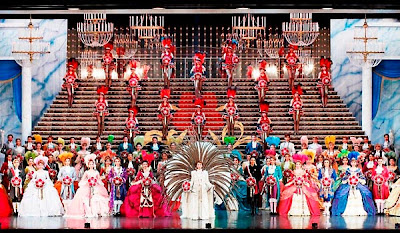 |
| One of many waterfalls near Bogyeongsa |
Not far from Pohang are two famous temples, one to the south called Oeosa, which you can read about here. And another to the north, called Bogyeongsa, which is the more popular of the two. I visited it several times while I was living in Pohang and probably the best times to see it are in the fall around the end of October or in the winter, around late December January.
From downtown Pohang, you can catch a bus or drive to Bogyeongsa. The bus takes about an hour and a half, possibly longer if you have to change buses. There will be more info about the buses at the end of this post. When you arrive, you'll find a big parking lot where the bus drops you off which leads into a small town.
 |
| Get your virility-improving liquor in Bogyeongsa |
There are some small shops and restaurants selling traditional food, souvenirs, and a kind of liquor that comes in a very unusual bottle. As the bottle topper suggests, drinking it is meant to improve virility.
The food in town is simple but tasty, with a lot of the usual things like pajeon (Korean pancake), noodles, bibimbap, etc. I've heard you can also get a kind of whole chicken cooked in soy sauce here, but I never visited with a large enough group to try it.
 |
| Bogyeongsa Temple |
 |
| Wall painting at Bogyeongsa |
Follow the main road past the shops and you'll find yourself at the temple complex. It's a fairly large one, with a mix of old and modern buildings. It has a few bilingual signs around the complex explaining the history of the buildings.
 |
| One of many temples in the Bogyeongsa complex |
The temples are really nice, but the main attraction at Bogyeongsa is the hike, which leads you past about 12 waterfalls if you follow it all the way to the end. Most people don't, since the biggest and most impressive falls are only about a 40 minute - 1 hour hike down the trail. It has some ups and downs but overall the trail is not very difficult, however it can be extremely crowded depending on the season and the day of the week. It's most crowded around the end of October when everyone comes to see the fall colors. If you don't mind hiking in a line of slow, older Koreans, it is worth it to see the waterfalls surrounded by the vibrant colors of the changing leaves.
 |
| Where most people end the hike, near the two biggest waterfalls |
 |
| Bridge over the falls |
 |
| One of the main waterfalls |
 |
| Beautiful fall colors around the end of October |
Perhaps a better time to go is in the winter, especially January, when the river and all the waterfalls freeze over. You can actually walk out on the water right up to the waterfalls (although please be very cautious when doing so!) and best of all, there will be hardly anyone else on the trail with you.
 |
| Walking out to the frozen waterfalls |
 |
| Exploring a bend on the frozen river |
 |
| The main falls frozen over |
If you're just interested in the waterfalls, don't bother with the rest of the trail as the other falls are small and difficult to see from some parts of the trail. But if you'd like a nice hike, it's much quieter along the second half and still very pretty, especially in the fall.
 |
| The much quieter second half of the trail |
 |
| One of the few nice falls along the 2nd half |
Bus Info:
If you plan on taking the bus to Bogyeongsa, you have a couple of options. You can take the 510 bus out to Bogyeongsa, which has numerous stops throughout downtown Pohang, including the stop by Jukdo Market (the same side of the street as the market) or by the shiway (intercity) bus terminal (across the street from the terminal.) The bus doesn't run very frequently, so try to check the schedule first. You can also take the 500 bus which runs more frequently than the 510 to Cheongha terminal (the bus's last stop) and wait there for the 510.
Checking the bus schedule is a little difficult if you don't speak Korean. You can try calling the tourist information hotline. Dial 1330 from a Korean phone or +82-2-1330. It has an English option. If you live in Pohang and know some Korean (enough to read and type Hangul on your phone), there is a very handy app with bus info you can download called 포항 버스 (Pohang Bus). You need to search for it in Korean to download it.
















Comments
Post a Comment